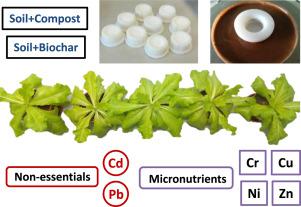Environmental Technology & Innovation ( IF 7.1 ) Pub Date : 2020-12-23 , DOI: 10.1016/j.eti.2020.101319 Marta Turull , Clàudia Fontàs , Sergi Díez

|
In this study, we have investigated the effect of two different organic amendments on trace metal transfer from soils to crops. Agricultural soils were mixed with (i) biochar (BC) at two levels (3% and 6%, w/w), and (ii) compost at one level (30%, w/w). Lettuce (Lactuca sativa L.) was planted, and at the end of growth, trace metals (Cd, Cr, Cu, Ni, Pb and Zn) were analysed in both plants and soil. To evaluate the bioavailability and mobility of labile trace metals, different methodologies were used, such as the diffusive gradients in thin films (DGT) technique, BCR sequential extraction and pore water extraction. It has been observed that the lettuces grown in soils with added compost, the amounts of Cd, Cr, Cu and Pb was 1.7, 2.4, 1.3 and 3.7 times lower, respectively, than those found in lettuces planted in soils with no amendment. Moreover, the addition of 3% of BC reduced the uptake of Cr (24%) whereas a 6% of BC reduced Cr (55%) and Pb (50%) levels. Using the DGT technique in soils with different organic matter (OM) content, labile fractions of Cr, Cu and Pb were successfully correlated (p 0.05) with lettuce total metal concentrations. In conclusion, BCR sequential extraction and DGT method have shown similar efficiency in front other methodologies, although it seems that DGT-methodology is faster and more cost-effective method than sequential extraction for predicting metal uptake by plants.
中文翻译:

薄膜扩散梯度评估不同改良剂对农业土壤中微量金属生物利用度和生菜中金属吸收的影响
在这项研究中,我们研究了两种不同的有机改性剂对痕量金属从土壤转移到农作物的影响。将农业土壤与(i)生物炭(BC)以两种水平(3%和6%,w / w)和(ii)堆肥以一种水平(30%,w / w)混合。生菜(莴苣L.)被种植,并且在生长结束时,对植物和土壤中的痕量金属(Cd,Cr,Cu,Ni,Pb和Zn)进行了分析。为了评估不稳定的痕量金属的生物利用度和迁移率,使用了不同的方法,例如薄膜中的扩散梯度(DGT)技术,BCR顺序萃取和孔水萃取。已经观察到,在添加了堆肥的土壤中生长的莴苣,其Cd,Cr,Cu和Pb的含量分别比未改良的土壤中种植的莴苣低1.7、2.4、1.3和3.7倍。此外,添加3%的BC降低了铬的吸收(24%),而添加6%的BC降低了Cr(55%)和Pb(50%)的水平。在不同有机质(OM)含量的土壤中使用DGT技术成功地关联了Cr,Cu和Pb的不稳定组分(p0.05)与生菜的总金属浓度。综上所述,BCR顺序萃取和DGT方法在前面的其他方法中显示出相似的效率,尽管似乎DGT方法比顺序萃取在预测植物吸收金属方面更快,更具成本效益。



























 京公网安备 11010802027423号
京公网安备 11010802027423号